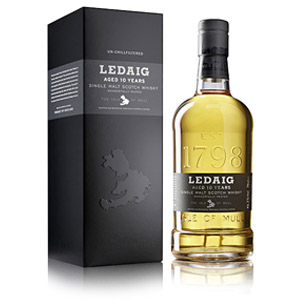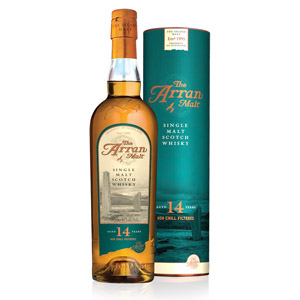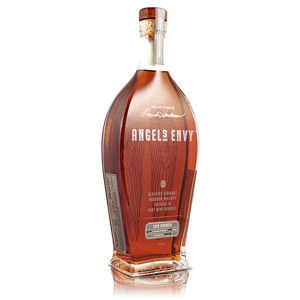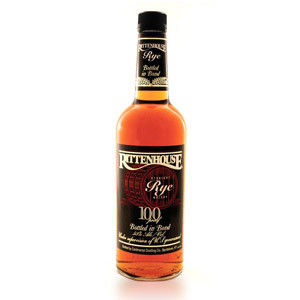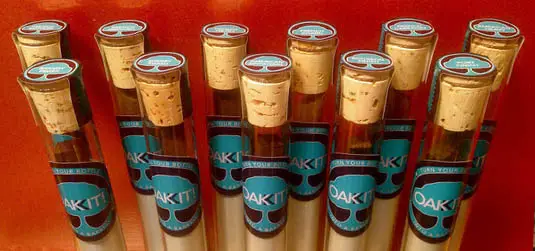
The aging-at-home industry appears to be picking up speed lately, with products such as Whisky Elements, Beyond Barrel Aging Masts (review upcoming), small barrels for home aging, and even wooden bottles! They all promise more-or-less the same thing: Take under-matured or middling-quality whisky (or other spirits) and quickly infuse them with a little extra oak flavor while also filtering out impurities and mellowing the spirit. As I discovered with my Whisky Elements review, the results are not so cut-and-dry. My conclusion then was that whisky exposed to “fast aging” via high surface-area sticks can end up with some funky flavors or sometimes it can have no detectable effect whatsoever. Yes the whisky changes, but not always for the better, and it doesn’t always raise the subjective quality of the whisky even by the price of the sticks! In other words, it hardly makes sense to put a $6 stick of wood into a $30 bottle in order to make the bottle taste like it’s worth $35!
I was contacted by the makers of Oakkits, a similar product to Elements but without the fancy cutting and charring. Instead, Oakkits are designed to approximate the surface area ratio of a 53-gallon whisky barrel in an attempt to avoid the pitfalls of quick aging with high surface area wood. I’ve also been told that the wood end-grain exposed in Elements is responsible for a lot of off flavors, while the side-grain (long fibers) are where the magic lies. If you think about the inside of a whisky barrel, all of the wood that’s actually exposed to whisky is side-grain. It makes sense to approximate this with sticks as well. In addition, Oakkits comes with “infusion tubes” to allow the customer to add a wine finish, and also comes with fabric to keep a flow of oxygen into the bottles while they age. More on both below.
When whiskymakers create wine-finished whiskies such as Glenmorangie Lasanta, they are often taking used sherry (or other wine) barrels that are still wet with sherry, having been freshly dumped. This means the wood fibers are still swollen with actual sherry. If allowed to dry out and drain some of that flavor could be lost. To approximate this effect, Oakkits provides glass tubes with corks that you can pour your own wine, port, madeira, etc., into to give the sticks a quick soak before going into the whisky bottle.
While most people think of oak barrels as airtight, they are actually able to “breathe”, meaning that oxygen cycles into and out of the barrel as it expands and contracts with temperature changes. This is the mechanism that causes the “Angel’s Share”, or evaporation of some amount of alcohol each year. It exits when air is “breathed” out of the barrel. This is also purportedly how barrels aged in seaside warehouses pick up some sense of the sea, as sea air enters and exits the barrels over time. There isn’t much air inside a barrel (unless it’s very old), but this constant air exchange and oxidation and evaporation all have a hand in maturing the whisky. To simulate that in an Oakkit, the package comes with a piece of muslin fabric to wrap around the cork, thus allowing a small amount of air to enter and exit the bottle.
Oakkits offers several different sticks including American Oak and French Oak in various levels of char. They provide a handy chart for matching your spirit to a wood type. The Oakkits for wine finishing do not come with the wine/port/etc. – you must provide that! Note that it takes less than a wineglass-full to infuse wine into two sticks. And, of course, you can drink the now-oaky wine afterwards. The sticks are intended to age whisky in the bottle for a minimum of six to eight weeks, with longer aging having a greater effect (you can leave them in even longer, they won’t over-oak the spirit). If you’re impatient, the instructions come with steps to accelerate the process by two to three weeks by moving the bottles periodically between the freezer and a warm place. I did not test this procedure.
Oakkits cost $10 per stick, making them pricier than Elements. There is also a three-stick minimum order.
Impressions and Test Procedure
First, some impressions of the kit I received for testing Oakkits (Disclosure: I was sent Oakkits for free for review purposes). Two of the glass vials had cracked around the cork opening during shipment. Luckily, the cracks were high enough to not leak when used to infuse wine, but I had to prop up the glass tubes. The sticks are not uniform, with some natural warping, splits, and variations in thickness. This make a few of them a little difficult to get into bottles (especially when swelled from soaking in port), but with some effort I managed it. I received enough sticks to test 8 half-bottles (375ml bottles): 4 with heavy-toast French oak, and 4 with port-soaked French oak. Each stick had been cut in half for my half-bottle experiments. I did not test any American oak Oakkits.
I soaked the port sticks in my favorite port, a Zinfandel Port from ParaVi Vineyards in Camino, CA. They soaked for about 60 hours, which was longer than the instructed 48 hours, and which might the reason for some of my port-related results (see below). I chose four whiskies, saving 50ml of each for comparison with the final tasting. First, the new Faultline Blended Scotch Whisky (Batch 1) from K&L Wines (review upcoming), which is a highly peated blend that I felt was lacking some oak and a little maturity. Next, Bushmills 10 year-old single-malt Irish whiskey (review upcoming), which had already seen both bourbon and oloroso sherry casks, but which I felt could stand a bump in flavor. Then, Buffalo Trace bourbon which I had also tested Whisky Elements with. Lastly, Macallan Fine Oak 10 year which is inexpensive and (judging by Macallan’s other malts) could definitely stand some more oak. That gave me one blended scotch, one light Irish whiskey, one bourbon, and one single malt scotch. I put the sticks into 375ml bottles of each whisky on 4/1/2015 and performed three tastings as they aged, with the final one on 6/14/2015 exactly 10.5 weeks after starting.
Feel free to skip to the bottom, with my conclusions.
TASTING ONE (5/5/2015 ~4 weeks)
All four have a slightly darker appearance. The Port bottles also have a slightly redder tinge.
Bushmills 10 French
Complexly perfumed. Apple flesh, vanilla, cocoa nibs verging on roasted coffee. Assorted tropical fruit (pineapple or papaya or something). Palate like nose, soft, caramel. Finish round and sweet. Very nice.
Bushmills 10 Port
Same as above, but with slightly more cocoa and a hint of chile powder, and less vanilla. Also harder – a little more acidic and less round and sweet. Prefer French. Palate has a big note of ruby port up front – strawberry, currant, plum. Finish is a little bitter, with detectable tannin, like the dregs of a red wine. OK.
Macallan 10 French
Resinous sherry up front, almonds, hay. Palate mild, slight fruitiness, jammy. Finish more of the same. A little better than OK.
Macallan 10 Port
Same as above. Palate as above, but with a lot of red wine tannin, grape skins, a little harsher. Finish same, some bitterness. Just OK.
Buffalo Trace French
Candy corn, vanilla syrup, plus BT classical notes (grassy, herbal). Palate classic, maybe with more honey. Finish same. OK.
Buffalo Trace Port
More acidity, raspberry, stale red wine. Palate same, but tannins immediately. Not fruity, exactly, but acerbic. Finish lots of tannin. Weird lip numbing. Just OK.
Faultline French
Mild peat. Plenty of hay. Not much else. Palate soft, some vanilla. Cigarette ash. Finish same. OK.
Faultline Port
Same, but with the slightest hint of red wine. Palate: tannins again. Some good peat/fruit balance. Finish too. Again, weird lip numbing. A little better than OK.
Overall: Port clearly adds tannin and some red wine character (anemic, though). Unable to determine if French oak is doing ANYTHING, except maybe adding some vanilla here and there. More time needed.
TASTING TWO (5/24/2015 ~7 weeks)
Ditto on color, not noticeably different from last time.
Bushmills 10 French
A nice dose of honey, now, with liberal vanilla and something like cinnamon. Not getting the fruit anymore. A lot of cinnamon on the palate, cinnamon rolls, with more wood tannin than before. Caramel still. Very soft. Coconut on the finish. Very nice.
Bushmills 10 Port
Sharper, more acidic nose. Some banana. Less of everything else. Port notes are on the palate, but hidden a bit. Strawberry preserves. Mild fruit. Not as acidic as last time, rounder and smoother. Still wine dregs on finish. Not quite as nice as French one.
Macallan 10 French
Nose same. Palate same. Maybe more fruit (??) on the finish, plus more marshmallow creme. Just OK.
Macallan 10 Port
Nose same. Palate has red wine notes, some jam, less harshness than before. Finish a bit like grape soda. Just OK.
Buffalo Trace French
Less grassy than before, otherwise still BT. Palate same. Finish same, but maybe with a little spice, like clove. A little better than OK.
Buffalo Trace Port
Bit more port character on nose – brambles, red wine. Palate same. Some jam. Finish same. A little better than OK.
Faultline French
A little more honey than before, with graham cracker. Maybe rounder on the palate, still cig ash. Sweeter? A little better than before.
Faultline Port
Also more honey. No detectable port. Also rounder on the palate. Where’s the wine? Identical?! Just OK.
TASTING THREE (6/14/2015 10.5 weeks) – FINAL
These tastings included the 50ml control samples.
Bushmills 10
Port one is markedly darker and with a reddish tinge. French oak one has the same color.
French
Much more perfumed – primarily sandalwood and vanilla. The industrial glue note is actually more prominent. Palate has scads of vanilla, bananas foster (cooked banana), leather, and a delicate sandalwood/incense note. Quite nice. Finish carries all of these on, particularly the leather/sandalwood. Overall impression is refined, soft, and with interesting exotic flavors that were not originally present. Final score: Very good. Worth it.
Port
Acidic red fruits are now present. On the palate, there is some red wine tannin (puckering), and a similar but much diminished sense of exotic/perfumed notes. Finish carries on the red wine tannin, plus extra nuttiness (chestnuts?) that weren’t present before. Final score: Just OK, only mildly improved. Not worth it.
Macallan 10
Both port and french are markedly darker.
French
Nose now has a buttery shortbread cookie aroma, but some of the resinous edges of the sherry character have been blunted. The palate is soft, and the sherry is supported by more oaky, buttery (like chardonnay) roundness. Finish is possibly slightly longer, with more gentle oak, again reminding me of chardonnay. Final score: Pretty good, probably not worth it.
Port
A very (very) mild red currant note has appeared on the nose, with the faintest hint of dark chocolate. The palate has a distinct red berry and red wine tannin note, and less obvious sherry character, as if the red wine has replaced the sherry. On the finish, however, the two are both present, and add up to a nice amount of fruit in the finish. Final score: Just OK. Not worth it.
Buffalo Trace
Port distinctly redder, French identical color.
French
Vaguely, slightly sweeter, with a little more dough aroma to the usual cinnamon-bun notes. On the palate, it is slightly rounder with perhaps a little less burn. Some elegant oak notes, but softer and sweeter than usual. Finish has a hint of hazelnuts and a little sandalwood, and finishes more gently. Final score: Decent, slightly improved, probably not worth it.
Port
Bright red fruits – plums or maybe dried cranberries enhance the existing bourbon nose. On the palate, there is a slight red wine tannin effect – like red wine dregs – and it finishes hot, with more cinnamon. There is also a puckering/drying effect likely from the wine tannin. Final score: Decent, slightly improved, probably not worth it.
Faultline
Both French and Port incredibly darker, red/gold color.
French
The difference on the nose, if any, is slight. A hint of blondie (cookie dough) and maybe slightly less vegetal/grassy quality. On the palate, there is definitely more oak, with layers of butterscotch and sweet baked goods, and far less “tequila”. The finish is only slightly more sweet. Final score: Pretty good. Marked improvement. Definitely worth it.
Port
More so than the French bottle, the Port one has overcome the grassiness on the nose, and added a malty caramel base with the faintest hint of fruit. On the palate there is an acidic red wine vinegar note, and not nearly as much caramel sweetness as the French bottle. The finish is a weird mixture of puckering red wine tannin and peat, which is… odd. Final score: Moderate improvement. Not worth it.
Conclusion
After doing a bunch of these tests, first with Whisky Elements and then with Oakkits, I’ve become pretty familiar with the effects that sticks of oak inserted into bottles of whisky can have. Everyone seems to be jumping on the “aging at home” bandwagon lately, trying to make a buck by increasing the apparent value of your whisky by two bucks. The dream, though, is marred by the reality. Sticks of charred, heat-treated, perforated, or otherwise manipulated oak simply do not imbue spirits with the same magical quality that a dozen years or more in oak casks do. With some sticks the timeframe is shorter because the surface area ratio (to liquid) is greater, but this quick aging does not produce the same sublime effects as slow aging in low-surface-area barrels does. With other sticks cut to approximate the surface area ratio in a full-sized barrel, the timeframe is longer but not nearly long enough (years) to have large effects. I also suspect that small amounts of wood can get exhausted, meaning that even a single bottle of liquid won’t pull any more flavor out after a few months. With both types, you can expect a few “spikes” of flavor to appear in your whisky (depending on several variables) but you may risk losing some flavors or aromas or introducing weird or undesirable new ones. On average, after testing 12 sticks in 8 different whiskies, I can categorically say that stick-aging does not increase the quality of your whisky by even the amount spent on the sticks. There have been exceptions (such as Speyburn 10 with Whisky Elements, and Faultline Blended Scotch with Heavy-Toast French Oakkits), but they aren’t worth the extensive testing that would be required to squirrel out the synergistic combinations of whisky brand and stick type that are actually worth it.
Note, also, that I chose to use the port sticks even though the aforementioned handy chart doesn’t recommend port sticks with scotch. I chose them because I’ve had several excellent port-finished single malts in the past, and because I had bottles of port on hand, but no sherry. It turns out this was probably a bad idea, as apparently oak sticks soaked in port do not have the same effect as port pipes do on single malt. You have been warned!
That said, the experience is definitely interesting and perhaps even fun. The activity might be worthwhile if viewed from the perspective of an experiment, especially if conducted with friends in a tasting group so that everyone can compare and contrast the results and share in the costs. Some people might even find that the $10 spent on sticks yields a $20 increase in the quality of their favorite whisky. Still other people who have always wished their favorite whisky had an element of fruit, a note of oak, or a smoothing out of rough edges may find fulfillment with a stick and make it part of their regular whisky rituals. Finally, it may be possible to vastly increase the quality of truly bottom-shelf booze like Dewar’s White Label or Rebel Yell bourbon, but at $10 a stick, you might be better off just buying better booze. Despite their faults, whisky aging sticks do make fun and unique gifts for whisky lovers.
Just don’t expect (like some customers might) that a $10 stick and 2 months of time can replace years of actual oak barrel aging. I wanted it to work as much or perhaps more than the next guy, but it just doesn’t, alas.

